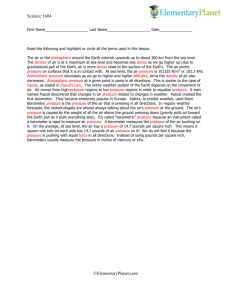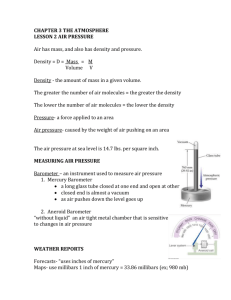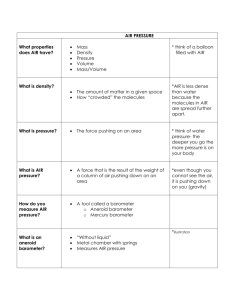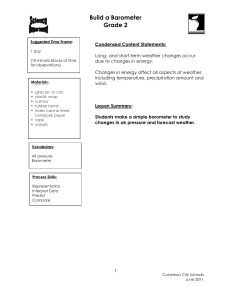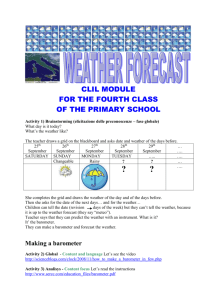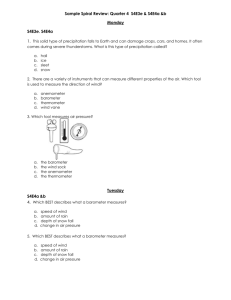Word Document
advertisement
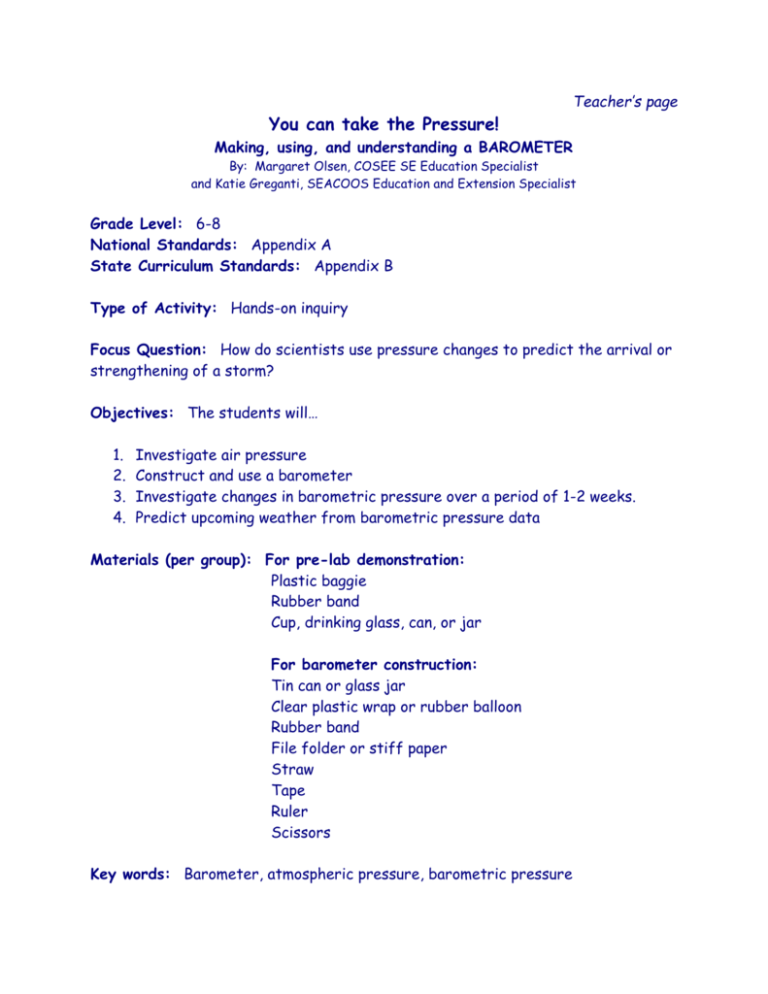
Teacher’s page You can take the Pressure! Making, using, and understanding a BAROMETER By: Margaret Olsen, COSEE SE Education Specialist and Katie Greganti, SEACOOS Education and Extension Specialist Grade Level: 6-8 National Standards: Appendix A State Curriculum Standards: Appendix B Type of Activity: Hands-on inquiry Focus Question: How do scientists use pressure changes to predict the arrival or strengthening of a storm? Objectives: The students will… 1. 2. 3. 4. Investigate air pressure Construct and use a barometer Investigate changes in barometric pressure over a period of 1-2 weeks. Predict upcoming weather from barometric pressure data Materials (per group): For pre-lab demonstration: Plastic baggie Rubber band Cup, drinking glass, can, or jar For barometer construction: Tin can or glass jar Clear plastic wrap or rubber balloon Rubber band File folder or stiff paper Straw Tape Ruler Scissors Key words: Barometer, atmospheric pressure, barometric pressure Teacher’s page BACKGROUND INFORMATION: A barometer is an instrument used to measure air pressure. One way air pressure is measured is in inches of mercury. Air pressure is highest as sea level, making the air also heaviest. At sea level, air pressure is 29.53 inches of mercury. This means that at sea level, it takes 14.7 pounds of pressure per square inch of air to raise mercury in a hollow tube to 29.53 inches in height. What is 14.7 pounds of pressure? Try pushing down on a scale at home until it reads “14.7.” You have exerted 14.7 pounds of pressure on that scale! A barometer is an instrument that measures the pressure of the atmosphere at a particular location. There are two types: a mercurial barometer which uses mercury, and an aneroid barometer that uses a balloon that expands or contracts when the atmospheric pressure changes. You may not notice in your experiment that the barometer reading changes in response to temperature as well as direct changes in pressure. Temperature changes pressure, but only in a tightly sealed space (your classroom is not tightly sealed to the outside.) Warmer air taking up the same amount of space as cold air will create more pressure. This is because warm molecules push away from one another instead of moving towards one another. The warm molecules try to take up more space than they have, creating a greater pressure pushing out of the container. Measuring atmospheric pressure is very important for predicting and preparing for storms. Barometers allow weather forecasters to estimate maximum hurricane wind speeds. Since air is always flowing from high pressure toward low pressure, air moves inward toward the low pressure center in a hurricane. By using a barometer to find the pressure in the center of the hurricane, forecasters can estimate the fastest wind speeds that the hurricane is capable of producing. Usually, when barometric pressure (or, pressure as shown on a barometer) falls rapidly, it means a storm is coming. A steady barometer shows stable, fair weather. The barometer saves lives since it helps predict the approach of poor weather. Back when RADAR and satellites didn’t exist, crude barometers were the main way people predicted the approach of bad weather like a hurricane or a major snow storm. PRE-LAB TEACHING STRATEGIES: 1. Demonstrate that air actually has pressure (or takes up space) by blowing up a plastic baggie and sealing it to the mouth of a jar with a rubber band. Hold the outside of the bag where it is attached to the jar and have a student try to push the baggie into the jar. Discuss with the students that the air pressure inside the jar prevents them from being able to push the baggie in- something’s already there! 2. Initiate a discussion about pressure. Why do your ears hurt when you dive deep into a pool? Does air weigh anything? Why don’t we feel air pressing down on us? Why does air push out of our ears making them “pop” when we go up in an airplane? 3. Discuss pressure in general with your class. Other than air, what other things exert pressure? Teacher’s page LAB NOTES: 1. If you use plastic wrap, have the students be careful not to tear it. 2. Stress that the balloon needs to be stretched as tightly as possible over the mouth of the can or jar. 3. When the air pressure is greater outside the can, the air will press down on the plastic wrap causing the straw to point up. 4. When the air pressure is greater inside the can, the air inside the can will push up on balloon or plastic wrap and the straw will point downward. 5. Have the students record their barometric pressure daily, inside and outside each day for 1-2 weeks. EXTENSIONS: 1. To demonstrate that temperature will affect the reading on the barometer, place the barometer in a pan of hot water and record what happens. 2. Have one student or group of students place their barometer in the direct sunlight. Ask your students compare this data and determine if the direct sunlight caused an inaccurate reading of atmospheric air pressure. 3. Have your students write a short report about how they think pressure on their barometer would change from beginning to end if the eye of a hurricane passed right over your school. 4. As a homework assignment, have your students draw a diagram about the relationship between temperature and pressure. They can find plenty of information online. Source: Revised from an existing activity by Margaret Eidson (Olsen). References: “Barometer,” Microsoft Encarta Online Encyclopedia 2005 http://encarta.msn.com 1997-2005 Microsoft Corporation. “Torcelli, Evangelista,” Microsoft Encarta Online Encyclopedia 2005 http://encarta.msn.com 1997-2005 Microsoft Corporation. Eidson, Margaret. Earthy Things. Idea Factory, Inc., Riverview, FL. 1990. pg 158160. Helpful web resources: http://inventors.about.com/library/inventors/blbarometer.htm http://www.quicksilver-barometers.co.uk/barometer%20info.html http://hyperphysics.phy-astr.gsu.edu/hbase/pman.html#atm http://kids.earth.nasa.gov/archive/air_pressure/index.html Teacher’s page Appendix A: National Science Education Standards Science as inquiry: Content Standard A: Abilities necessary to do scientific inquiry; Understandings about scientific inquiry Physical Science: Content standard B: Properties and changes of properties in matter Earth and Space Science: Content Standard B: Properties and changes of properties in matter Science and Technology: Content Standard E: Abilities of technological design; Understandings about science and technology Science in Personal and Social Perspectives: Content Standard F: natural hazards; Science and technology in society Appendix B: State Science Education standards Georgia Department of Education: Performance standards Curriculum Revision Process http://www.georgiastandards.org/science.asp North Carolina Department of Public Instruction – Standard Course of Study http://community.learnnc.org/dpi/science/ http://www.ncpublicschools.org/curriculum/science/ South Carolina Department of Education http://www.myschools.com/offices/cso/science/default.cfm Environmental Education http://www.myschools.com/offices/CSO/enved/default.cfm Student’s page Making your barometer OBJECTIVE: Construct and use a barometer, understand atmospheric pressure MATERIALS: tin can or glass jar clear plastic wrap or rubber balloon rubber band file folder or stiff paper straw tape scissors PRODCEDURE: 1. Cut a piece of plastic wrap or balloon at least two inches larger than the mouth of the can or jar 2. Stretch the plastic wrap or balloon tightly across the mouth of the can or jar. 3. Attach the plastic wrap/balloon with a rubber band. 4. Cut a strip of file folder three inches wide and two inches longer than your can/jar is tall. 5. On the outside edge of this strip, write “HIGH” towards the top of the strip and “LOW” towards the bottom of the strip. Between the words, mark of a line every ¼ inch. This is your scale. Label each line 1,2,3,4,5 with 1 at the LOW side. 6. Tape the scale to your can or jar. 7. Clip one end of the strap to make a point. Tape the other end of the straw to the plastic wrap/balloon on the top of your can. You may need to cut some of the length of the straw off so that the pointed end of the straw will point toward your scale. 8. Place your barometer in a safe area and record your barometric pressure reading each day. Take readings outside in the shade. Let your barometer sit for five minutes before taking a reading. Compare your inside and outside barometric temperature. 9. Record your data. Student’s page OBSERVATIONS/QUESTIONS 1. Where was the air pressure the greatest, inside or outside? Explain why this is. 2. What happened to the straw when the air pressure increased? Why? 3. What happened to the straw when the air pressure decreased? Why? 4. What happened to the straw when the air pressure decreased? Why? 5. What factors affected your barometer data? 6. Research hurricanes and explain how the atmospheric pressure determines the strength of a hurricane. CONCLUSIONS: Explain in your own words what a barometer is and how it works. Next, explain how atmospheric pressure is used to estimate hurricane wind speeds. Student’s page DATA TABLES Week: _____ INSIDE READING OUTSIDE READING INSIDE READING OUTSIDE READING INSIDE READING OUTSIDE READING Day 1 Day 2 Day 3 Day 4 Day 5 Week: _____ Day 1 Day 2 Day 3 Day 4 Day 5 Week: _____ Day 1 Day 2 Day 3 Day 4 Day 5

